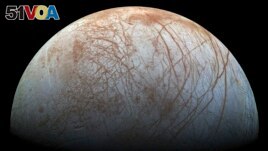10 March 2024
A new study suggests Jupiter's icy moon Europa produces much less oxygen than previously thought.
The study was based on data collected by the American space agency NASA's Juno spacecraft. Juno is an orbiter that has been studying Jupiter since July 2016.
The study involved Juno's instruments measuring levels of oxygen and hydrogen molecules coming from Europa's atmosphere. The data showed the icy moon produces about 1,000 tons of oxygen every 24 hours. NASA said that amount would be enough "to keep a million humans breathing for a day.

This image made available by NASA in 2014 shows Jupiter's icy moon Europa in a reprocessed color view, made from images captured by NASA's Galileo spacecraft in the late 1990s. (NASA/JPL-Caltech/SETI Institute via AP)
However, the space agency noted those oxygen level estimates were "substantially less" than those measured in earlier studies about the moon.
Europa is a little smaller than Earth's moon. But it is still one of the largest in our solar system. NASA observations have suggested an ocean exists beneath a thick layer of ice on Europa's surface. Scientists estimate the moon's ocean may contain twice the amount of water as Earth's oceans.
The new study is based on data Juno collected in 2022 during a particularly close flyby of Europa. The flyby is believed to have brought the spacecraft within 350 kilometers of the moon.
The research was led by teams from Princeton University in New Jersey and Maryland's Southwest Research Institute. The scientists estimated Europa is producing around 12 kilograms of oxygen per second. Earlier predictions suggested the moon was releasing up to 1,000 kilograms per second.
Since Europa is believed to have a large ocean under its surface, researchers in the past identified it as a good candidate to hold the right conditions to support some form of life. That data came mainly from telescope observations of oxygen levels existing in the moon's icy surface.
The new, lower oxygen estimates do not support the earlier observations. The team involved in the study said more research will be needed to confirm the latest findings.
Scott Bolton is a Juno investigator at the Southwest Research Institute and a co-writer of the study. He said in a statement that the team's new findings have a direct effect on the possibility that Europa could be habitable. While the oxygen amounts measured were much lower, the latest study gives scientists "a narrow range that could support habitability," Bolton said.
Princeton University researcher Jamey Szalay was the study's lead writer. He said, "The findings unambiguously demonstrate oxygen is continuously produced at the surface, just a good bit lower than we expected."
Szalay added that Juno's flyby of Europa marked the first time a spacecraft was able to directly measure the moon's atmosphere. "We couldn't wait to peek behind the curtain of its complex environment," he wrote to The Associated Press in an email.
The researchers said the new measurements can help scientists gain a better understanding of Europa and its environment, and "open the door for newer, more precise models."
Robert Ebert is a researcher at the Southwest Research Institute and a co-writer of the study. He said that even with the new results, he believes further investigations should take place to search for signs of life on Europa. "Water is important for the existence of life... Europa is a good place to search for water within our solar system."
NASA hopes to launch its Europa Clipper mission in October. This orbiter is designed to carry out close examinations of Europa. It will look for signs it might hold the right conditions to support life.
NASA says the orbiter plans to fly in orbit around Jupiter and "perform repeated close flybys of the ice moon."
I'm Bryan Lynn.
Bryan Lynn wrote this story for VOA Learning English, based on reports from The Associated Press, NASA, Nature Astronomy and the Southwest Research Institute.
_____
Words in This Story
substantial – n. large in amount
habitable – adj. able to support life
unambiguous – n. expressed in a very clear way
peek behind the curtain – n. get a look at something not normally seen
precise – adj. very clear or exact











